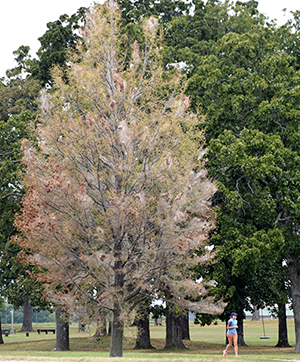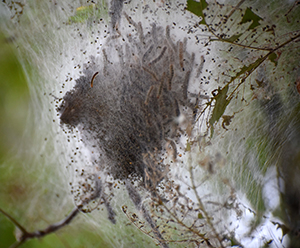Fall Webworms

Fast Facts
- Fall webworms are not to be confused with bagworms or eastern tent caterpillars.
- Webworms form their nests on the tips of tree branches.
- Though the webs are very unsightly, damage to most trees is considered to be insignificant.
- The first visible signs of infestation occur when beige to brown webs begin to irregularly enclose the ends of upper branches.
What are fall webworms?
Fall webworms are a native moth that occurs through all of North America, and now the world, thanks to their accidental introduction to Europe during World War II. The noticeable stage of this ugly pest usually appears from June through August in Arkansas, but if a second generation is produced, can extend into October.
Infestations tend to be episodic in nature with back to back bad webworm years occurring about once a decade. However, some webworms will be seen almost every season.
Are there different types?
Two races of fall webworm are described: the two-generation-a-year, black-headed version and the single-generation-a-year, orange-headed form. Both races occur in the South, but the orange-headed form is perhaps a bit more common. The moth usually lays her eggs around mid-June, and about 60-70 days are required to go from egg to pupal stage. The black-headed form begins about four weeks earlier and is able to squeeze in a second generation.
What are the signs of an infestation?

The first visible signs of infestation occur when beige to brown webs begin to irregularly enclose the ends of upper branches. In the initial stages the small, hairy yellow-brown worms feed only on the upper surface of the leaf, but as the size of the caterpillar increases the whole leaf is eaten.
As the colony consumes the initial leaves in the vicinity of where the inch-wide white moth laid its hundreds of eggs, the size of the webby mass increases. The frass from all of the feedings remains in the thick web and becomes piteously ugly. For the first half of the 4- to 6-week period during which the caterpillars feed, all feeding is in the confines of the web. As caterpillars near maturity at 1¾ inch long they leave the web at night to feed.
During the final stage of development, caterpillars leave the web and crawl to a convenient hiding place, such as a thick patch of bark or the leaf litter at the base of the tree, where they form a ¾ inch long brownish pupal case where they overwinter.
Still not sure if you have webworms? Ask our Pest Crew.
What trees are most vulnerable?
The range of trees attacked by this pest is impressive. Worldwide, more than 600 kinds of deciduous trees have been attacked, but favorites in Arkansas include sweetgum, crabapples, persimmons, black walnut, pecan, hickory, cherry, river birch, and occasionally even elms and willows.
Because the fall webworm does its most significant damage during the hottest and driest part of the season when most trees have stopped growing anyway, their damage is primarily considered of only aesthetic concern.
How do I get rid of webworms?
Sprays of BT (Bacillus thurin-giensis) or Sevin directed at the webs and surrounding foliage as soon as they are noticed provide effective control. During late summer and early fall there is no control needed or recommended. However, on trees, such as pecans and other fruit which have not fully developed yet, control may be warranted.
For additional information on webworm control contact your local County Extension Office.